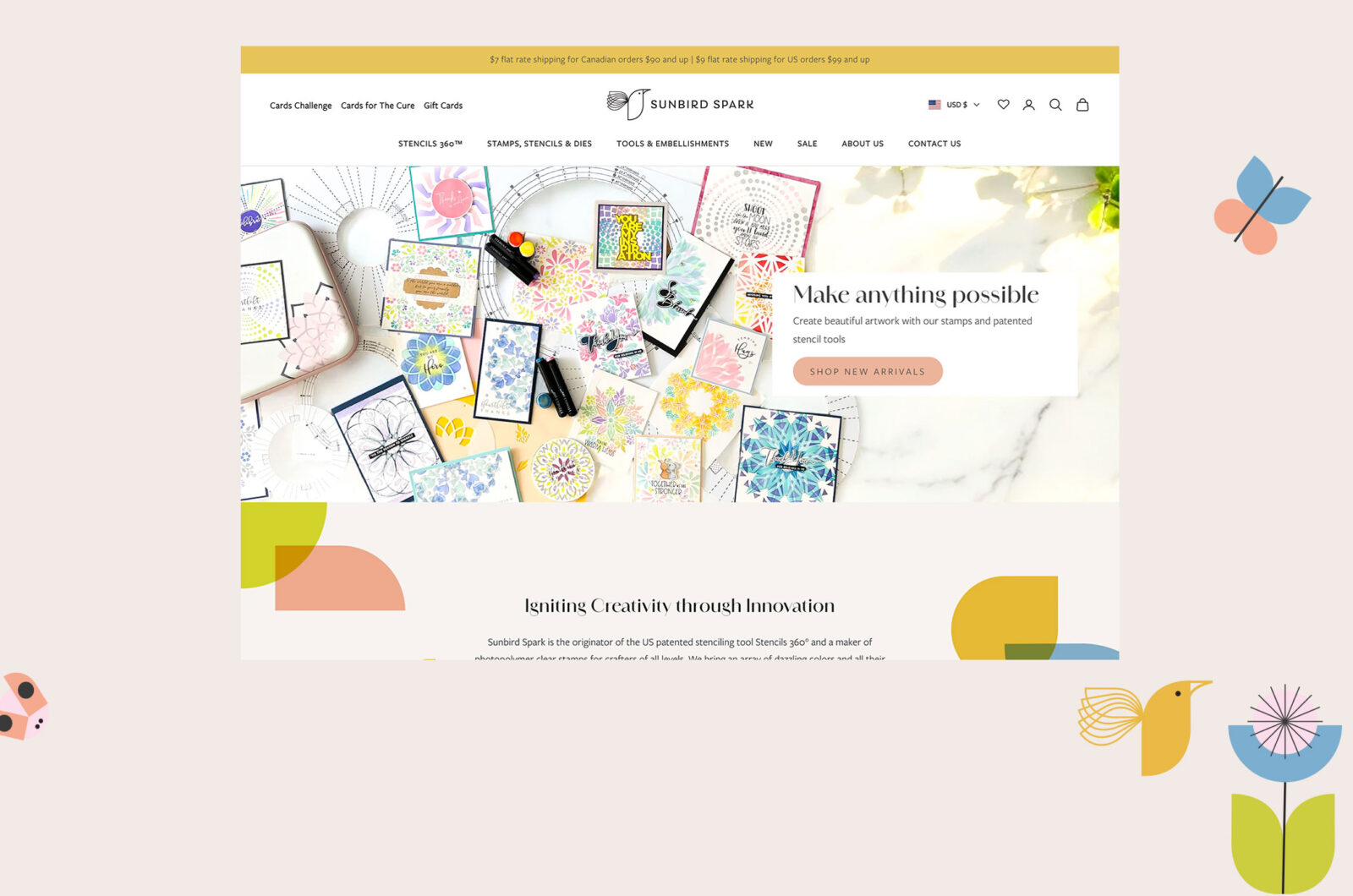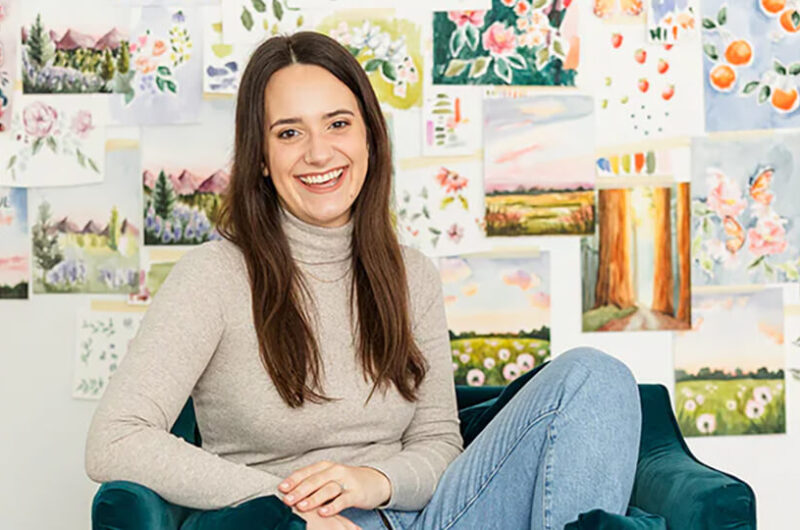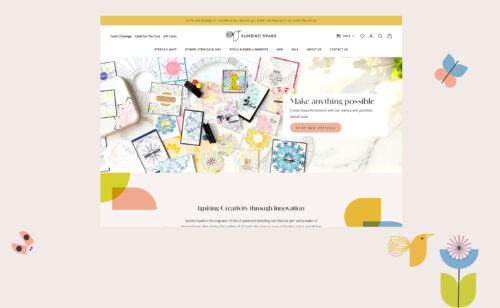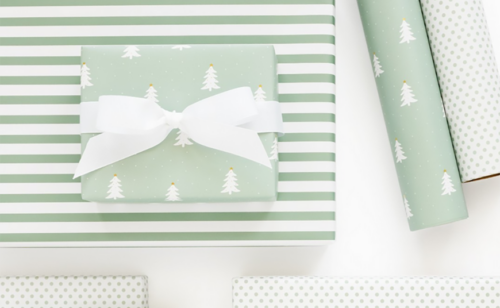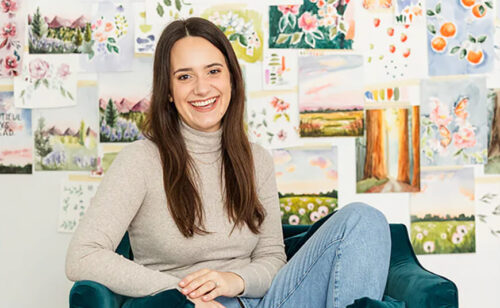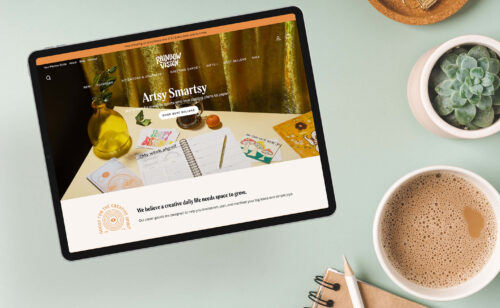
This interview is with Ashley Brown of Secret Holiday & Co., an artist, and maker who has found her own way to be a “big little” handcrafted business. She has a product that resonates with people, is memorable, and which transcends trends. I think you’ll be interested to hear about the choices she’s made along her path.
Questions are in bold, Ashley’s replies are not. Enjoy!
What do you create and what makes it so darn special?
I spend most of my days making Affirmation Banners. I created the very first ‘IT’S OK’ Banner back in 2010 because I needed the reminder for myself. I had been researching images from the Women’s Suffrage Movement and was really drawn to the banners & flags they created for protest marches. I had grand ideas about using their straightforward ‘black text on white ground’ to create banner-like quilts, but I was working 4 part-time jobs to make ends meet and I couldn’t find the time to bring any of my ideas to fruition.
One afternoon I created the very pared-down minimalist ‘IT’S OK’ banner as a small reminder to myself to keep with my plans, to keep moving forward, even if it was slower going than I wanted. I put the same care and attention into that one little banner as I had been intending to put into my project quilts – trying to replicate the incredible handiwork of the late 19th century. I posted an image of my banner on Flickr and it just took hold. I think my dedication to fine-craftsmanship and the simplicity of the statement is what draws many people to my work.
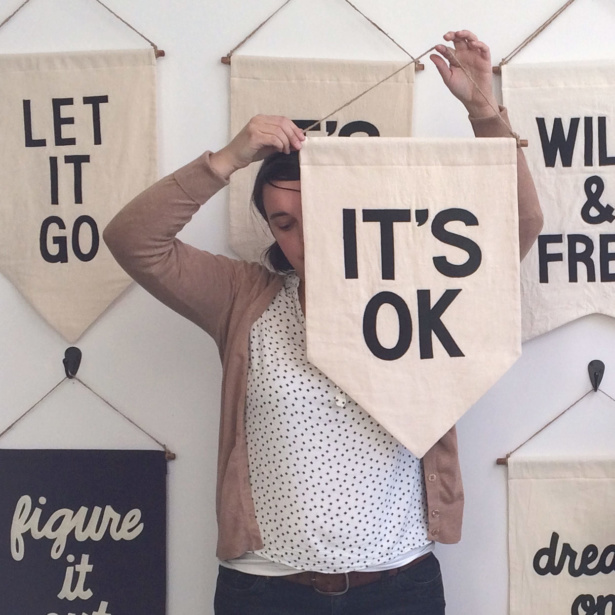
Is your product entirely handmade? Could you describe who makes your product and how? How has that changed over the life of your business?
Currently my products are 100% handmade by me. Each banner is carefully cut, stitched, assembled, and finished in my home studio. I have tried outsourcing production in a couple of different ways: hiring a part time sewing assistant in-house, and also sending out piece-work. While both options offered a bit of relief on the production end of things, I didn’t enjoy the added job of being someone’s boss.
Operating as a one-person business can be hard and overwhelming at times (and I tend to work more hours each week than I would like), but having an employee brought up other challenges that I quickly learned I wasn’t interested in overcoming, at least for the time being. I may try piece-work again in the future, but for now, I truly enjoy making in a small batch capacity. Part of what keeps this business going, even when it feels overwhelming, is that I still get an incredible feeling of satisfaction when I complete a banner. I’ve made nearly 5000 Affirmation Banners in the past six years and I get that special feeling every single time. I like to think that those good vibes end up in each piece.
For weekly tips like this, subscribe to our newsletter
"*" indicates required fields
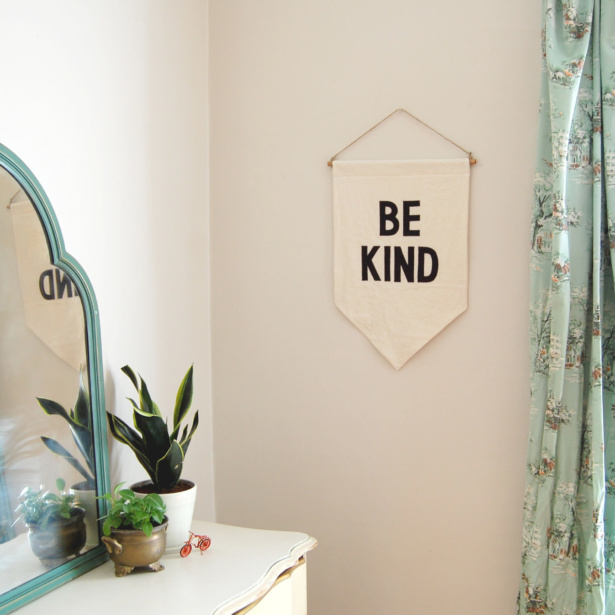
How long have you been in business? What can you pinpoint as a turning point in your business’ popularity?
I’ve been selling my handmade work since 2005. I was on Etsy in the early days – when it was easier to stand out and selling art on the internet still felt new and incredibly exciting. For the first few years I sold small plush creatures that I called Fern Animals, and did pretty well with it. I graduated art school in 2007 and felt confident at that time that I’d be able to cobble together an art career of my own design. I participated in many indie craft fairs, made connections with lots of other makers, and built a comfortable reputation online as the “maker movement” was beginning to gather steam.
I bounced around a bit with my work – – selling Fern Animals, then custom Love Birds as wedding cake toppers, and occasionally some small quilts or other textile pieces. I felt pretty successful, but was also always willing to have various non-career part time jobs and live pretty poor in order to prioritize my creative work. In 2010 my Affirmation Banners were born and everything came into focus. They became popular pretty quickly via Flickr, Pinterest, and then Instagram, and by 2012 I was able to quit my day job and create full time.
I got my first large wholesale order from Schoolhouse Electric & Supply Co. around then, and it felt like a huge turning point. I think that was about the time I felt like I’d “made it”, or at least I had a bit more security in my work. That being said, it’s pretty easy to be hard on yourself and never think you’ve truly succeeded. If you told me seven years ago that I’d be producing exclusive products for Urban Outfitters and struggling to answer all my wholesale inquiries, I would’ve been blown away, but once you’re in it it’s easy to still think you could be doing better.

How often do you release products, and how quickly do they sell out? Is your shop ever empty?
Over the years I have tried out a number of ways to sell my product: having scheduled updates consisting only of items ready to ship, scheduled updates selling pre-order listings, or having my shop generally always “stocked” on a made-to-order basis. All ways have worked well, and it’s exciting to build hype with a scheduled update and then sell out really quick. But fielding the many emails that tend to follow about why the shop is empty or when the next update will be has always felt like too much extra work.
I’m pretty consistently terrible at email (or anything involving sitting at the computer) because I’d rather be working in my studio, so I’ve gotten comfortable having my shop always on pre-order. Sometimes I will make a limited run in a special colorway, or host a scheduled sample sale, and both of these events tend to sell out within an hour or two. It works well for me to make the “classic” designs as they sell, and create new special pieces a couple times a month to keep my customers – and me – excited about my work.
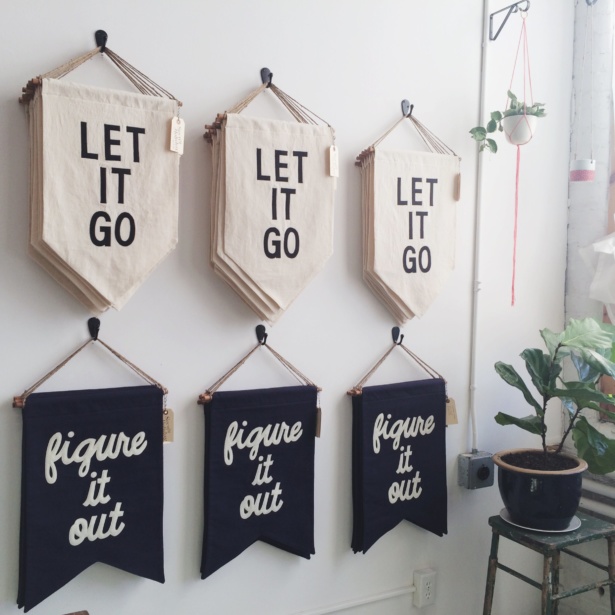
How have you adjusted pricing, processes, and methods as demand outpaced supply, and how did that affect inventory and sales?
When I first started, I was greatly underselling myself, as I think most artists and makers do. You just want to get your work out there and you’re not really thinking in terms of profit or sustainability. Once I started gaining traction with my Affirmation Banners and realized that I absolutely could not afford to wholesale them with the low retail price I had set, I started gradually raising the price to a more practical amount.
It’s funny how needing to hire an assistant and wanting to be a good employer who pays a living wage helped me realize that I was being a terrible employer to myself. I was working insanely long days, often 7 days a week, to keep up with the demand for probably less than minimum wage. And while my higher prices have allowed room for numerous businesses to pop up and sell a similar-looking product for a fraction of the cost of mine, I believe strongly in “you get what you pay for” and that you have to value your own work if you expect anyone else to to value it.

Have you found ways to sell or share your work in a more widespread way? How is that working out?
I’ve tried out a few things here and there over the years, but it always felt like I was trying to get away with something. Like everyone would see through the product and know I was just searching for a way to make more money with less work. I’m probably over thinking that one. But I’ve always felt very strongly about not selling something that I couldn’t stand behind 100%. Prints, notecards, etc., have just never felt like the right product for me. But I do have a special secret thing in the works right now that will hopefully be a sort of meeting-in-the-middle. Still a bit of work on my end, still a high quality product, but not as time-consuming to produce or expensive to buy. We’ll see if it works out! 🙂
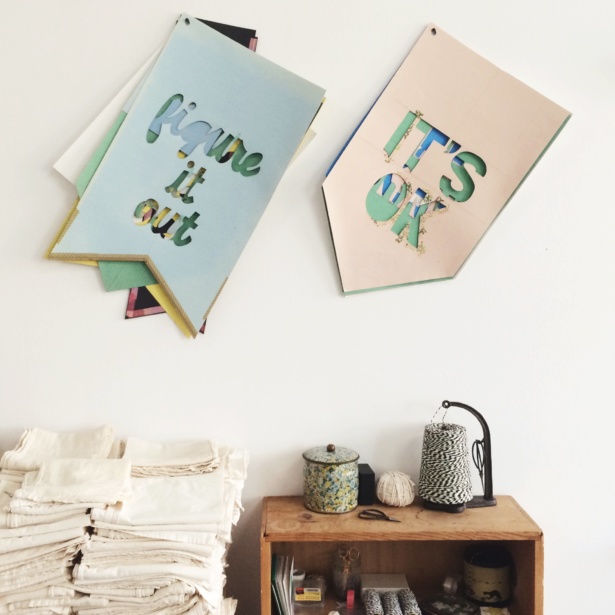
Where do you promote your work most? How do you sell it? How much time do you spend on marketing or promotional work?
For the past few years I have been using Instagram pretty exclusively to promote my work. I’ve never bought advertising or put much time or money into promotion, besides a handful of blogger trades or discounts. I have benefitted greatly from the simple fact that my banners stand out in a photo – even if one is hanging in the far back corner of a shot, you can still see it, still read it.
Because each piece has such a bold, positive statement on it, many people will share photos of my banners hanging in their homes just to spread the sentiment, or set the tone of their Instagram update. And I am truly lucky that I have so many customers with beautiful homes! I repost my favorite customer-shot images onto my own feed, tagging the photographer, which in turn brings more people to post and tag me. I like to think we’re all promoting and encouraging each other 🙂 Maintaining a visually pleasing Instagram account has been my great promotional effort.
In addition to Instagram, I use MailChimp to send out brief updates to my mailing list. Typically this is when I am having a big sale, or have a new product or workshop to promote. I sell most of my work directly, through my online store. I use both Instagram (on a daily basis) and MailChimp (generally bi-monthly) to link customers to my shop. I also sell a range of banners through about a dozen online and brick & mortar retail shops.

What do you like about how you sell your handmade goods? What about your selling process is not ideal for you?
I like keeping things small and being directly connected to my customers. While it is a lot of work and can be stressful at times, maintaining close contact keeps me feeling grounded and reminds me why I do what I do. At the end of the day, these are real people who want my work, and I’m spreading positivity all over the world. That’s a good feeling!
The thing I struggle the most with is letting go enough to accept help when it’s needed. I particularly loathe basically all aspects of the “business” side of things. I just want to be making the work! But I have to do the administrative stuff to keep the business running, so I do it (begrudgingly). Hopefully there will come a day in the not-too-distant-future when I can find someone I trust enough to take over all the little admin jobs that make me cringe…
Is your business financially sustainable?
I think I can say yes to this question. I’ve been a professional maker for more than a decade, and while my income is always fluctuating, each year I get a little better at preparing for those fluctuations. I’m proud and humbled that this little banner-making business of mine supports my family. We are far from wealthy and still have tough months some times, but we’re comfortable and doing work we both love (my husband is also an artist).

How do you see your business growing in the next few years? Do you intentionally keep it small? Would you like to expand? If so, how?
When I see many young indie businesses building up around me, growing and expanding and outsourcing, it is tempting to think that I want that for my own business, or that I should want that. But really, at the end of the day I am an artist, a maker. I simply love to make things with my own two hands. I don’t want to be the CEO of my business, whether it be big or small. I like sitting at my sewing machine every day, I like having a hand in every piece I send out the door. For me, my little business is about creating beautiful, high quality work and spreading positivity.
I do intentionally keep my operation small. I am very happy with where I am at. The only thing I would like to alter is to find more time to explore my other creative interests. I think the biggest challenge of staying small and not hiring out production of my current product line is being too busy fulfilling orders to create new designs. But I make it work! I carve out a bit of time here and there. It’s like a fancy dance. I just need to make it a priority to carve out a little bit more.
What advice or encouragement would you give to other hand-makers?
Be true to who you are. If you are making a product you believe in wholeheartedly, and making it to the best of your ability with the best materials you can find, it will be easy to sell your product because you’ll know you are offering your very best.
Ashley is such a hard-working business owner! Shop Secret Holiday & Co. at secretholidayco.com and check out her Instagram: @secretholidayco
A Newsletter That Goes Beyond Shopify 101
It’s easy to find beginner info about ecommerce online. If you’re past that? Subscribe to our newsletter for advanced strategies and need-to-know info for established shops. You'll get:
- Weekly tips to help you market and sell your products
- Updates when there is news that may impact your site
- Round ups of interesting links and info for brands
- Invites to our live trainings and webinars
- Instant access to our past emails
"*" indicates required fields
Related Posts
Let's take your online shop to the next level
The Shopify websites we design have a reputation for substantial improvements to ecommerce conversion rates and online sales. Let's talk!

